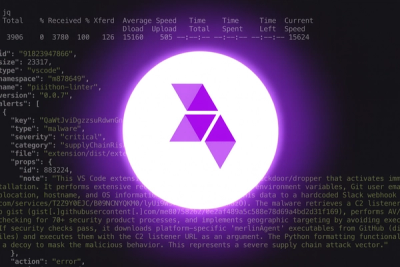
Product
Introducing Webhook Events for Alert Changes
Add real-time Socket webhook events to your workflows to automatically receive software supply chain alert changes in real time.
@weweb/prerenderer
Advanced tools
Fast, flexible, framework-agnostic prerendering for sites and SPAs.
Fast, flexible, framework-agnostic prerendering for sites and SPAs.

Note: This package is unstable and still under active development. Use at your own risk.
The goal of this package is to provide a simple, framework-agnostic prerendering solution that is easily extensible and usable for any site or single-page-app.
prerenderer-webpack-plugin is now deprecated, but still functional. It will be replaced by prerender-spa-plugin v3 in the near future.
Now, if you're not familiar with the concept of prerendering, you might predictably ask...
Recently, SSR (Server Side Rendering) has taken the JavaScript front-end world by storm. The fact that you can now render your sites and apps on the server before sending them to your clients is an absolutely revolutionary idea (and totally not what everyone was doing before JS client-side apps got popular in the first place...)
However, the same criticisms that were valid for PHP, ASP, JSP, (and such) sites are valid for server-side rendering today. It's slow, breaks fairly easily, and is difficult to implement properly.
Thing is, despite what everyone might be telling you, you probably don't need SSR. You can get almost all the advantages of it (without the disadvantages) by using prerendering. Prerendering is basically firing up a headless browser, loading your app's routes, and saving the results to a static HTML file. You can then serve it with whatever static-file-serving solution you were using previously. It just works with HTML5 navigation and the likes. No need to change your code or add server-side rendering workarounds.
In the interest of transparency, there are some use-cases where prerendering might not be a great idea.
prerenderer Usage(It's much simpler if you use prerenderer with webpack or another build system.)
Input
app/
├── index.html
└── index.js // Whatever JS controls the SPA, loaded by index.html
Output
app/
├── about
│ └── index.html // Static rendered /about route.
├── index.html // Static rendered / route.
├── index.js // Whatever JS controls the SPA, loaded by index.html
└── some
└── deep
└── nested
└── route
└── index.html // Static rendered nested route.
const fs = require('fs')
const path = require('path')
const mkdirp = require('mkdirp')
const Prerenderer = require('@prerenderer/prerenderer')
// Make sure you install a renderer as well!
const JSDOMRenderer = require('@prerenderer/renderer-jsdom')
const prerenderer = new Prerenderer({
// Required - The path to the app to prerender. Should have an index.html and any other needed assets.
staticDir: path.join(__dirname, 'app'),
// The plugin that actually renders the page.
renderer: new JSDOMRenderer()
})
// Initialize is separate from the constructor for flexibility of integration with build systems.
prerenderer.initialize()
.then(() => {
// List of routes to render.
return prerenderer.renderRoutes([ '/', '/about', '/some/deep/nested/route' ])
})
.then(renderedRoutes => {
// renderedRoutes is an array of objects in the format:
// {
// route: String (The route rendered)
// html: String (The resulting HTML)
// }
renderedRoutes.forEach(renderedRoute => {
try {
// A smarter implementation would be required, but this does okay for an example.
// Don't copy this directly!!!
const outputDir = path.join(__dirname, 'app', renderedRoute.route
const outputFile = `${outputDir}/index.html`
mkdirp.sync(outputDir)
fs.writeFileSync(outputFile, renderedRoute.html.trim())
} catch (e) {
// Handle errors.
}
})
// Shut down the file server and renderer.
prerenderer.destroy()
})
.catch(err => {
// Shut down the server and renderer.
prerenderer.destroy()
// Handle errors.
})
@prerenderer/renderer-jsdom - Uses jsdom. Extremely fast, but unreliable and cannot handle advanced usages. May not work with all front-end frameworks and apps.@prerenderer/renderer-puppeteer - Uses puppeteer to render pages in headless Chrome. Simpler and more reliable than the previous ChromeRenderer.prerenderer 0.6.0:prerenderer.BrowserRenderer - Opens the system default browser to render the page. (Use @prerenderer/renderer-jsdom or @prerenderer/renderer-puppeteer instead.)prerenderer.ChromeRenderer - Uses Google Chrome in headless mode over RDP. (Use @prerenderer/renderer-puppeteer instead.)Use @prerenderer/renderer-puppeteer if: You're prerendering up to a couple hundred pages (bye-bye RAM!).
Use @prerenderer/renderer-jsdom if: You need to prerender thousands upon thousands of pages, but quality isn't all that important, and you're willing to work around issues for more advanced cases. (Programmatic SVG support, etc.)
| Option | Type | Required? | Default | Description |
|---|---|---|---|---|
| staticDir | String | Yes | None | The root path to serve your app from. |
| indexPath | String | No | staticDir/index.html | The index file to fall back on for SPAs. |
| server | Object | No | None | App server configuration options (See below) |
| renderer | Renderer Instance or Configuration Object | No | new PuppeteerRenderer() | The renderer you'd like to use to prerender the app. It's recommended that you specify this, but if not it will default to @prerenderer/renderer-puppeteer. |
| Option | Type | Required? | Default | Description |
|---|---|---|---|---|
| port | Integer | No | First free port after 8000 | The port for the app server to run on. |
| proxy | Object | No | No proxying | Proxy configuration. Has the same signature as webpack-dev-server |
constructor(options: Object) - Creates a Prerenderer instance and sets up the renderer and server objects.initialize(): Promise<> - Starts the static file server and renderer instance (where appropriate).getOptions(): Object - Returns the options used to configure prerenderergetServer(): (Internal Server Class) - Gets the instanced server class. INTERNALgetRenderer(): (Instanced Renderer Class) - Gets the instanced renderer class. INTERNALmodifyServer(Server: Server Instance, stage: string) - DANGEROUS Called by the server to allow renderers to modify the server at various stages. Avoid if at all possible. INTERNALdestroy() - Destroys the static file server and renderer, freeing the resources.renderRoutes(routes: Array<String>): Promise<Array<RenderedRoute>> - Renders set of routes. Returns a promise resolving to an array of rendered routes in the form of:[
{
route: '/route/path', // The route path.
html: '<!DOCTYPE html><html>...</html>' // The prerendered HTML for the route
},
...
]
@prerenderer/renderer-jsdom Options| Option | Type | Required? | Default | Description |
|---|---|---|---|---|
| maxConcurrentRoutes | Number | No | 0 (No limit) | The number of routes allowed to be rendered at the same time. Useful for breaking down massive batches of routes into smaller chunks. |
| inject | Object | No | None | An object to inject into the global scope of the rendered page before it finishes loading. Must be JSON.stringifiy-able. The property injected to is window['__PRERENDER_INJECTED'] by default. |
| injectProperty | String | No | __PRERENDER_INJECTED | The property to mount inject to during rendering. Does nothing if inject isn't set. |
| renderAfterDocumentEvent | String | No | None | Wait to render until the specified event is fired on the document. (You can fire an event like so: document.dispatchEvent(new Event('custom-render-trigger')) |
| renderAfterElementExists | String (Selector) | No | None | Wait to render until the specified element is detected using document.querySelector |
| renderAfterTime | Integer (Milliseconds) | No | None | Wait to render until a certain amount of time has passed. |
@prerenderer/renderer-puppeteer Options| Option | Type | Required? | Default | Description |
|---|---|---|---|---|
| maxConcurrentRoutes | Number | No | 0 (No limit) | The number of routes allowed to be rendered at the same time. Useful for breaking down massive batches of routes into smaller chunks. |
| inject | Object | No | None | An object to inject into the global scope of the rendered page before it finishes loading. Must be JSON.stringifiy-able. The property injected to is window['__PRERENDER_INJECTED'] by default. |
| injectProperty | String | No | __PRERENDER_INJECTED | The property to mount inject to during rendering. Does nothing if inject isn't set. |
| renderAfterDocumentEvent | String | No | None | Wait to render until the specified event is fired on the document. (You can fire an event like so: document.dispatchEvent(new Event('custom-render-trigger')) |
| renderAfterElementExists | String (Selector) | No | None | Wait to render until the specified element is detected using document.querySelector |
| renderAfterTime | Integer (Milliseconds) | No | None | Wait to render until a certain amount of time has passed. |
| skipThirdPartyRequests | Boolean | No | false | Automatically block any third-party requests. (This can make your pages load faster by not loading non-essential scripts, styles, or fonts.) |
| consoleHandler | function(route: String, message: ConsoleMessage) | No | None | Allows you to provide a custom console.* handler for pages. Argument one to your function is the route being rendered, argument two is the Puppeteer ConsoleMessage object. |
| [Puppeteer Launch Options] | ? | No | None | Any additional options will be passed to puppeteer.launch(), such as headless: false. |
| [Puppeteer Navigation Options] | ? | No | None | Any additional options will be passed to page.goto(), such as timeout: 30000ms. |
prerenderer only works for SPAs that route using the HTML5 history API. index.html#/hash/route URLs will unfortunately not work.replace: false on root components.Copyright (c) 2017 Joshua Michael Bemenderfer
Permission is hereby granted, free of charge, to any person obtaining a copy
of this software and associated documentation files (the "Software"), to deal
in the Software without restriction, including without limitation the rights
to use, copy, modify, merge, publish, distribute, sublicense, and/or sell
copies of the Software, and to permit persons to whom the Software is
furnished to do so, subject to the following conditions:
The above copyright notice and this permission notice shall be included in all
copies or substantial portions of the Software.
THE SOFTWARE IS PROVIDED "AS IS", WITHOUT WARRANTY OF ANY KIND, EXPRESS OR
IMPLIED, INCLUDING BUT NOT LIMITED TO THE WARRANTIES OF MERCHANTABILITY,
FITNESS FOR A PARTICULAR PURPOSE AND NONINFRINGEMENT. IN NO EVENT SHALL THE
AUTHORS OR COPYRIGHT HOLDERS BE LIABLE FOR ANY CLAIM, DAMAGES OR OTHER
LIABILITY, WHETHER IN AN ACTION OF CONTRACT, TORT OR OTHERWISE, ARISING FROM,
OUT OF OR IN CONNECTION WITH THE SOFTWARE OR THE USE OR OTHER DEALINGS IN THE
SOFTWARE.

Joshua Bemenderfer |
FAQs
Fast, flexible, framework-agnostic prerendering for sites and SPAs.
We found that @weweb/prerenderer demonstrated a not healthy version release cadence and project activity because the last version was released a year ago. It has 2 open source maintainers collaborating on the project.
Did you know?

Socket for GitHub automatically highlights issues in each pull request and monitors the health of all your open source dependencies. Discover the contents of your packages and block harmful activity before you install or update your dependencies.

Product
Add real-time Socket webhook events to your workflows to automatically receive software supply chain alert changes in real time.

Security News
ENISA has become a CVE Program Root, giving the EU a central authority for coordinating vulnerability reporting, disclosure, and cross-border response.

Product
Socket now scans OpenVSX extensions, giving teams early detection of risky behaviors, hidden capabilities, and supply chain threats in developer tools.